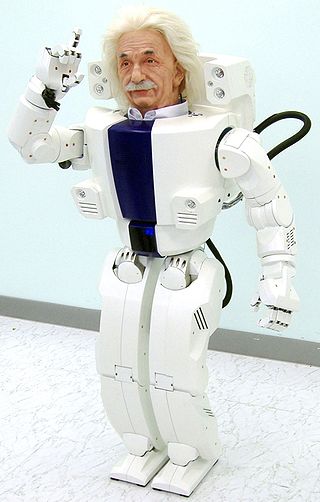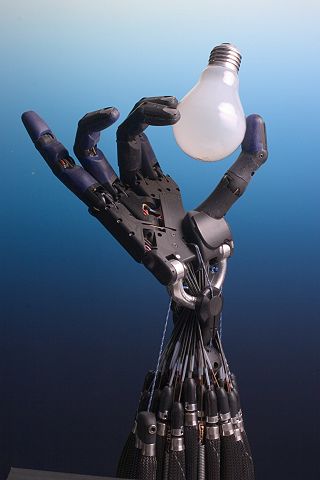
An android is a humanoid robot or other artificial being often made from a flesh-like material. Historically, androids were completely within the domain of science fiction and frequently seen in film and television, but advances in robot technology now allow the design of functional and realistic humanoid robots.
An autonomous robot is a robot that acts without recourse to human control. The first autonomous robots environment were known as Elmer and Elsie, which were constructed in the late 1940s by W. Grey Walter. They were the first robots in history that were programmed to "think" the way biological brains do and meant to have free will. Elmer and Elsie were often labeled as tortoises because of how they were shaped and the manner in which they moved. They were capable of phototaxis which is the movement that occurs in response to light stimulus.

A humanoid robot is a robot resembling the human body in shape. The design may be for functional purposes, such as interacting with human tools and environments, for experimental purposes, such as the study of bipedal locomotion, or for other purposes. In general, humanoid robots have a torso, a head, two arms, and two legs, though some humanoid robots may replicate only part of the body, for example, from the waist up. Some humanoid robots also have heads designed to replicate human facial features such as eyes and mouths. Androids are humanoid robots built to aesthetically resemble humans.

A gynoid, or fembot, is a feminine humanoid robot. Gynoids appear widely in science fiction film and art. As more realistic humanoid robot design becomes technologically possible, they are also emerging in real-life robot design. Just like any other robot, the main parts of a Gynoid include sensors, actuators and a control system. Sensors are responsible for detecting the changes in the environment while the actuators, also called effectors, are motors and other components responsible for the movement and control of the robot. The control system instructs the robot on what to do so as to achieve the desired results.

In aesthetics, the uncanny valley is a hypothesized relation between an object's degree of resemblance to a human being and the emotional response to the object. Examples of the phenomenon exist among robotics, 3D computer animations and lifelike dolls. The rising prevalence of digital technologies has propagated discussions and citations of the "valley"; such conversation has enhanced the construct's verisimilitude. The uncanny valley hypothesis predicts that an entity appearing almost human will risk eliciting cold, eerie feelings in viewers.

HUBO is a walking humanoid robot, head mounted on a life-size walking bipedal frame, developed by the Korea Advanced Institute of Science and Technology (KAIST) and released on January 6, 2005. According to Hubo's creator Prof Jun-Ho Oh and his Plenary Session at ICRA 2012 entitled Development Outline of the Humanoid Robot: HUBO II the name Hubo is simply a name, not an abbreviation.

Actroid is a type of android with strong visual human-likeness developed by Osaka University and manufactured by Kokoro Company Ltd.. It was first unveiled at the 2003 International Robot Exhibition in Tokyo, Japan. Several different versions of the product have been produced since then. In most cases, the robot's appearance has been modeled after an average young woman of Japanese descent.

In Japan, popular robots include humanoid entertainment robots, androids, animal robots, social robots, guard robots, and many more. Each type has a variety of characteristics.

Albert HUBO is a humanoid robot, based on the HUBO, but with an animatronic head in the likeness of Albert Einstein. Introduced in 2005, Albert HUBO is the world's first walking humanoid robot with an android head. It was developed by Joon-Ho Oh of KAIST in conjunction with Hanson Robotics, who developed the head. Albert HUBO served as the ambassador of "DYNAMIC KOREA", an initiative by the government of South Korea to rebrand and promote its technology internationally. Albert HUBO is capable of making many facial expressions and interacting with people.

Thomas P. Riccio is an American multimedia artist and academic. He received his BA from Cleveland State University in English Literature in 1978, his MFA from Boston University in 1982, and studied in the PhD program in Performance Studies at New York University from 1983 to 1984. Riccio has directed over one hundred plays at American regional theatres, off-off and off Broadway and has worked extensively in the area of indigenous and ritual performance conducting research and/or creating performances in: South Africa, Zambia, Burkina Faso, Tanzania, Kenya, Ethiopia, Europe, Russia, Siberia, Korea, India, Nepal, China, and Alaska. In 1993 the People's Republic of Sakha declared him a “Cultural Hero”.

Hiroshi Ishiguro is a Japanese engineer and director of the Intelligent Robotics Laboratory, part of the Department of Systems Innovation in the Graduate School of Engineering Science at Osaka University, Japan. A notable development of the laboratory is the Actroid, a humanoid robot with lifelike appearance and visible behaviour such as facial movements.

Robotics is an interdisciplinary field that involves the design, construction, operation, and use of robots.
The following outline is provided as an overview of and topical guide to robotics:
BINA48 is a robotic face combined with chatbot functionalities, enabling simple conversation facilities. BINA48 is owned by Martine Rothblatt's Terasem Movement. It was developed by Hanson Robotics and released in 2010. Its physical appearance is modeled after Bina Aspen, Rothblatt's wife.
Frubber is a patented elastic form of rubber used in robotics. The spongy elastomer has been used by Hanson Robotics for the face of its android robots, including Einstein 3 and Sophia.

Nadine is a gynoid humanoid social robot that is modelled on Professor Nadia Magnenat Thalmann. The robot has a strong human-likeness with a natural-looking skin and hair and realistic hands. Nadine is a socially intelligent robot which returns a greeting, makes eye contact, and can remember all the conversations had with it. It is able to answer questions autonomously in several languages, simulate emotions both in gestures and facially, depending on the content of the interaction with the user. Nadine can recognise persons it has previously seen, and engage in flowing conversation. Nadine has been programmed with a "personality", in that its demeanour can change according to what is said to it. Nadine has a total of 27 degrees of freedom for facial expressions and upper body movements. With persons it has previously encountered, it remembers facts and events related to each person. It can assist people with special needs by reading stories, showing images, put on Skype sessions, send emails, and communicate with other members of the family. It can play the role of a receptionist in an office or be dedicated to be a personal coach.

Soft robotics is a subfield of robotics that concerns the design, control, and fabrication of robots composed of compliant materials, instead of rigid links. In contrast to rigid-bodied robots built from metals, ceramics and hard plastics, the compliance of soft robots can improve their safety when working in close contact with humans.

Sophia is a social humanoid robot developed by the Hong Kong-based company Hanson Robotics. Sophia was activated on February 14, 2016, and made its first public appearance in mid-March 2016 at South by Southwest (SXSW) in Austin, Texas, United States. Sophia is marketed as a "social robot" that can mimic social behavior and induce feelings of love in humans.
Hanson Robotics Limited is a Hong Kong-based engineering and robotics company founded by David Hanson, known for its development of human-like robots with artificial intelligence (AI) for consumer, entertainment, service, healthcare, and research applications. The robots include Albert HUBO, the first walking robot with human-like expressions; BINA48, an interactive humanoid robot bust; and Sophia, the world's first robot citizen. The company has 45 employees.

Ribo is the first social humanoid robot which can speak in Bengali. Ribo was created by RoboSUST, a robotics group of Shahjalal University of Science & Technology, Bangladesh. The team was supervised by Muhammed Zafar Iqbal. Bangladesh Science Fiction Society funded for making this humanoid robot Ribo. Ribo was first appeared in public on 11 December 2015 in a Science Fiction Festival held at the Public Library, Shahbag.















